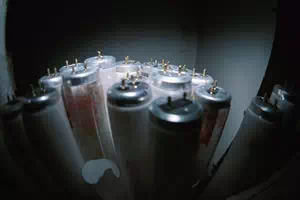|
 Waste Reduction—Fluorescent Lamps Waste Reduction—Fluorescent Lamps
Tradeoffs
Fluorescent lamps use one quarter the energy of incandescent lamps and last as much as ten times longer. The use of fluorescent lighting in healthcare facilities can significantly reduce energy consumption
However, fluorescent lamps contain small amounts of mercury. The release of mercury into the environment can create serious problems.
To reap the benefits greater efficiency while minimizing the mercury burden on the environment, fluorescent lamps must be disposed of responsibly. Fluorescent lamps are classified as hazardous wastes under federal rules. This means, among other things, that it is illegal to dispose of them in dumpsters as common municipal waste. Note that the same hazardous waste rules apply to other mercury- containing lamps, including:
- High-intensity discharge (HID)
- Neon
- Mercury vapor
- High pressure sodium
- Metal halide

Universal Waste Status
Hazardous waste disposal rules are somewhat burdensome, but for certain common items, including fluorescent lamps, the rules give you a break. Used fluorescent lamps are among a number of hazardous waste products that qualify for special treatment under a classification referred to as universal waste. Other examples of these wastes include batteries, thermostats (such as mercury-containing thermostats), and certain waste pesticides. EPA established the universal waste rule as a way to encourage recycling efforts. Under the universal waste rule, a hazardous waste generator has the option of handling eligible types of waste according to somewhat less stringent regulations. Individual states can modify the federal (EPA) regulations, so the rules that apply to your facility will depend on your location. Some states allow additional wastes, beyond those on the federal list, to qualify as universal wastes. See the Universal Waste State Resources Locator for detailed information on your state.

Source Control
Not all fluorescent bulbs are created equal. Low-mercury, or "green end cap" lamps contain less mercury than common lamps. Hazardous waste status is determined according to the quantity of toxic material released when the waste material is subjected to a mild acid (the so-called toxicity characteristic leaching procedure or TCLP). Some lamps may have a sufficiently small quantity of mercury that they pass the TCLP test, and are therefore not considered hazardous wastes. However, these lamps still contain small quantities of mercury and, whatever their regulatory status, they should be safely handled and disposed of to protect the environment.
Purchasing lamps that are both highly efficient and have low mercury content is beneficial in some unexpected ways. Of course, lamps that require less energy and that do not need to be replaced as frequently can be much less costly over their service life. And their lower mercury content poses less risk of releasing mercury to the environment at end-of-life. But high-efficiency lamps also reduce the environment's mercury burden during their service life. Most of the electricity used in the U.S. comes from burning coal. Mercury is typically present in coal, and is released when coal is burned -- in fact, power plants are the leading sources of mercury contamination. By reducing the demand for electricity, the use of fluorescent lamps mitigates that source of mercury emissons as well.

Recycling
Using efficient fluorescent lamps reduces pollution — and so does recycling them when they are spent. Establishing an effective and sustainable recycling program at your facility basically involves:
- Assessing your facility –how many fluorescent lamps do you use?
- Choosing a recycler
- Storing used lamps in Universal Waste-compliant containers
- Properly managing broken lamps
- Keeping records
Here are two useful guides to help you establish a recycling program:
Recycling companies can also be an effective resource when establishing your recycling program. There are various sources available for finding a recycling company. Check below under More Resources.

More Resources
Establishing a Recycling Program for Mercury-Containing Light Bulbs. Outlines steps that businesses can undertake to properly manage used universal waste lamps.

|

